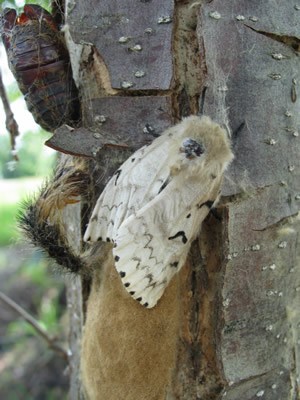Spongy Moth's Introduction & Spread in the U.S.
The spongy moth is a leaf-eating insect belonging to the insect order Lepidoptera, which includes butterflies and moths. The damage caused by defoliating caterpillars makes this insect one of America's most destructive pests of trees and shrubs. The spongy moth was introduced to Massachusetts from Europe in 1869 by the French lithographer and amateur entomologist Etienne Leopold Trouvelot. While conducting breeding experiments, the insect escaped from his laboratory and became established on nearby vegetation. The infestation grew slowly and local residents noticed defoliation when the first outbreak occurred 10 years after its initial introduction.
After several failed attempts to eradicate the spongy moth, the United States government realized that this insect would continue be a serious problem. In the early 1900s, a federal quarantine was placed on all trees in the infested area. Nurseries wanting to transplant trees from the quarantined area had to conduct a thorough inspection to ensure the moth wasn't hitching a ride. Quarantine restrictions kept the moth isolated in the New England region for decades.
Since its introduction, the spongy moth has slowly spread westward from New England despite efforts to control this pest. The spongy moth’s ability to feed and survive on more than 300 types of trees and woody plants, and a lack of natural predators has allowed this pest to invade North America's hardwood forests.

The spongy moth continues to expand its North American range westward. Female spongy moths are unable to fly and egg masses are deposited in protected areas near the tree that they were feeding on as caterpillars. However, the females will lay their eggs on natural or man-made objects. When outdoor house hold articles are moved from infested areas, the spongy moth can “hitch hike” and their range can rapidly expand. Household objects left outdoors during the summer can become infested with spongy moth egg masses. Examples of household objects that are typically infested with spongy moth egg masses include firewood, car wheel wells, grills or any outdoor household article or lawn ornament.
The spongy moth range has greatly expanded from the initial introduction point. Its range now extends northward to the Canadian Maritime Provinces, south to North Carolina, and west to Wisconsin and eastern Minnesota.
Spongy Moth in Minnesota
The MDA, in partnership with federal, state, tribal, and local officials, has been trapping spongy moth since 1973 and treating since 1980. Since the first northern Minnesota treatments around Schroeder in 2006, the MDA has taken action to prevent and stifle the growth of spongy moth populations in Lake and Cook Counties. Populations have now grown to a point where treatments are ineffective and the MDA has to turn to other management strategies to contain the infestation.
The first spongy moth quarantines were enacted in 1912 in New England. Minnesota is the 21st state to be quarantined for this invasive species. Quarantines in other states have benefited Minnesota’s forest resources by keeping them spongy moth free until now. Minnesota’s spongy moth quarantine will protect uninfested forests to the west and south.
Minnesota-Milestones for Spongy Moth
1969: First signs of spongy moth appear in Duluth (egg masses and pupal cases)
1973: Annual trapping program begins with 550 traps set
1976: First male moth trapped in the state (Hennepin County)
1980: First isolated spongy moth infestation, St. Paul Minnesota. Insecticide applications conducted eradicating the insect from the site.
2004: Minnesota joins the national Spongy Moth Slow the Spread program.
2014: Cook and Lake Counties become quarantined due to the presence of reproducing populations

